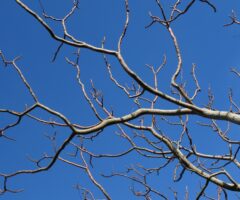When you’re looking to add a new tree, shrub, or plant to your yard, it usually is planted to serve a purpose. Maybe you’d like more shade, want to add structure to the landscape or create a windbreak or additional privacy. For several ornamental trees and shrubs, however, the color or visual interest they bring to a yard is the main consideration.
Below, we describe some of our favorite shrubs and small trees that brighten up mid-Michigan gardens in both fall and spring. The list of shrubs with two seasons of interest includes popular favorites, as well as some you may not have thought of, including:
- Ninebark
- Witch Hazel
- Forsythia
- Lilac
- Viburnum
Keep reading to learn more about these colorful and decorative plants and see if they’re right for your property!
Ninebark (Physocarpus opulifolius)
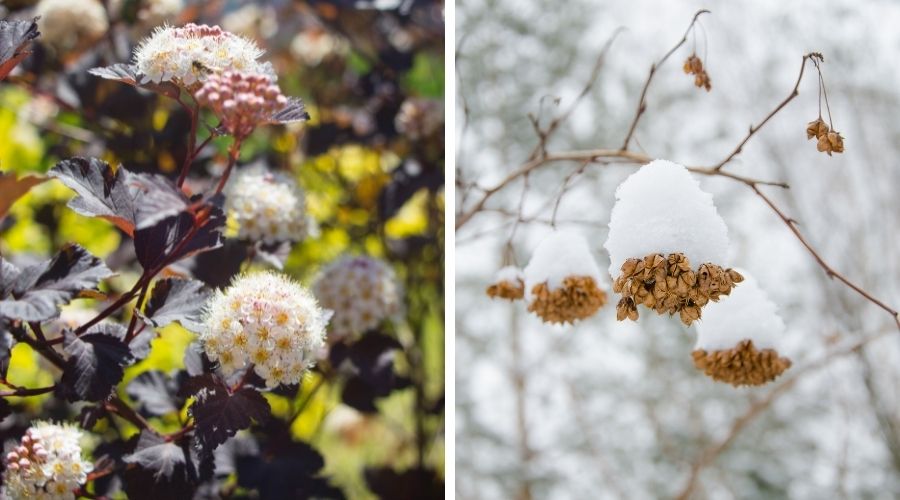
At a Glance
- Fall foliage: Variety of colors, most common is deep purple
- Spring flowers: Small white and pink blooms, don’t last long
- Size: Can reach full size in the first year, can be too large for some homeowners. Size-dependent on the variety chosen, 3-8 feet tall, 3-12 feet wide
- Planting requirements: Sun
- Issues: Needs lots of pruning to maintain size, can have powdery mildew. Thinning out stems can prevent some mildew thanks to increased airflow.
Popular Varieties
- ‘Summer Wine’ – purple foliage
- ‘Dart’s Gold’ – golden-yellow foliage, white flowers
- ‘Amber Jubilee’ – read about this specific cultivar in our article on hardy flowering shrubs
- ‘Little Devil’ – dwarf (grows to 4 feet), burgundy-purple leaves, white flowers
About Ninebark
Ninebark has interesting foliage and spring flowers, but also provides visual interest during the winter months. The bark on older stems can peel back in layers, which can be unusual and attention-grabbing for a shrub. In fact, its name, ninebark, refers to the layers and colors found below the bark on mature plants, revealed as it naturally peels back.
Ninebark is found in both the Upper and Lower Peninsulas of Michigan, normally along rivers or streams. It can handle a variety of soil types and survives well through cold winters, making it ideal for our climate.
Bees, hummingbirds, butterflies, and other pollinators enjoy the late spring flowers. To promote flowering, prune ninebarks after they bloom. You can also prune before new growth starts in late winter, but you won’t have flowers that year.
Either way, ninebarks provide not only spring interest but fall and winter too!
Common or American Witch Hazel (Hamamelis virginiana)
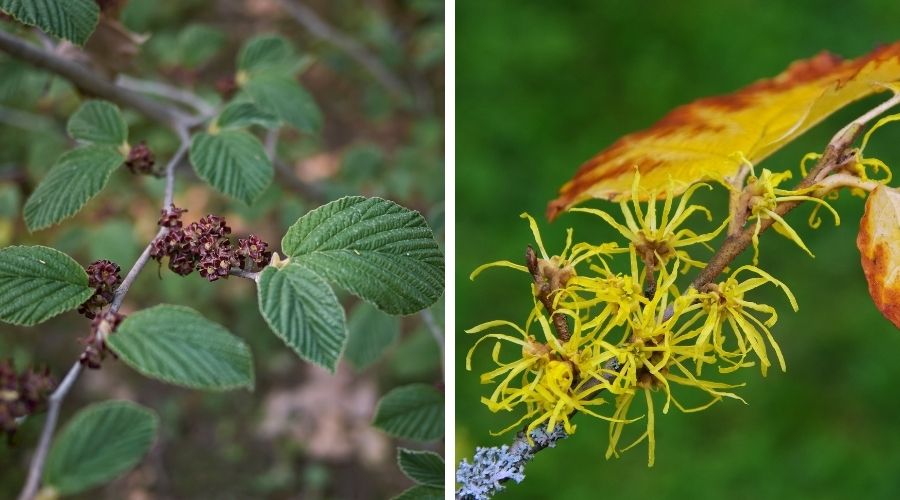
At a Glance
- Foliage: Orange or yellow leaves
- Spring flowers: None, fall colors are stringy lemon yellow
- Size: 15-20 feet tall, up to 20 feet wide, can be pruned as a tree
- Planting requirements: Part-shade (4-6 hours of sunlight a day), does well in many soil types (some drainage needed), often planted on the north side of homes in semi-shaded locations.
- Issues: Chlorosis in leaves in alkaline soils.
Popular Varieties
Some gardeners prefer Asian witch hazels (H. japonica and H. mollis), which bloom in spring and have no fragrance.
- Jelena – Japanese witch hazel with bronze flowers
- Diane – Japanese witch hazel with red flowers
- Livia – Japanese witch hazel with deep red flowers
About Witch Hazel
Witch hazel (or witch-hazel) can be grown as a small tree or a large shrub, and what makes it unique is that the flowers bloom in the fall. After the witch hazel plant drops its leaves, the thick yellow blooms start to appear. (Some non-native varieties, such as the Chinese witch hazel, bloom in early spring).
The fall blooms can appear as the orange-colored leaves drop, making for an interesting combination of colors and shapes. The late blooms provide pollen for pollinators such as moths that are still around, making witch hazel an important food source.
As if that wasn’t interesting enough, witch hazel plants also have seed pods that ripen in the fall. The seeds don’t just fall to the ground, though. Instead, the seedpods shoot the seeds out – sometimes sending the seeds 10 to 20 feet away!
Native witch hazel can be found throughout the Lower Peninsula of Michigan but only in some western areas of the Upper Peninsula.
Prune after the flowers bloom to ensure flowers the next year. Deer tend to leave witch hazel alone.
Forsythia
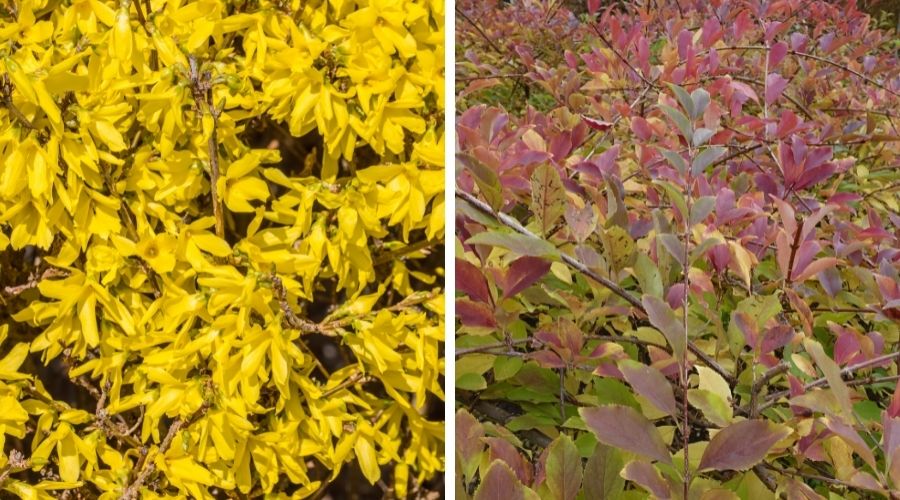
At a Glance
- Foliage: One of the last shrubs to drop their leaves, can turn yellow, gold, or purple-red
- Spring flowers: Golden yellow
- Size: 3-10 feet tall, can grow 2 feet a year
- Planting requirements: Needs a lot of room for the branches to spread out, plant in full sun, and well-draining soil
- Issues: Can become overgrown if not pruned regularly (yearly after they have finished blooming is best). Considered invasive in some areas.
Popular Varieties
- Lynwood Gold
- Northern Gold
- Spring Glory
- Gold Tide
About Forsythia
Forsythia is one of the first plants to bloom in our area each spring. It is deer-resistant, grows quickly, and can be used as a hedge or as a single shrub. You can cut branches from forsythia bushes to bring indoors for a nice pop of yellow in a vase.
Forsythia is “stoloniferous,” which means that when one of the branches reaches the ground, that branch can begin to root and turn into another bush. This unusual way of spreading can be good if you don’t mind additional forsythia bushes but can become an issue if you don’t want it to take over a large area of your property.
Be aware that some places consider forsythia invasive. It can grow unwieldy and can be difficult to remove, and the root systems can cause problems.
However, those same qualities that make forsythia plants or trees difficult to eradicate also mean that they can survive many harsh conditions. They are hard to kill, in other words. They will still need watering (especially when first planted) and some regular pruning, but they do well in most locations – even against a wall.
Lilac (Syringa spp.)
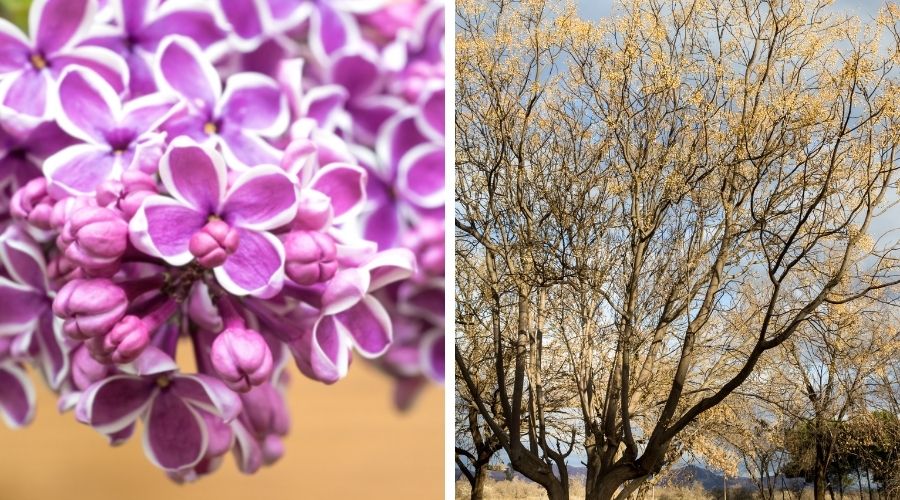
At a Glance
- Fall foliage: Can be red, purple, or gold in fall, depending on the type
- Spring flowers: Come in 7 different colors/shades
- Size: 6-33 feet tall, depending on the variety and cultivar
- Planting requirements: Plant in full sun with good air circulation, don’t overwater
- Issues: Powdery mildew, blight, some pests
Popular Varieties
There are over 2,000 cultivars and hybrids just of common lilac (Syringa vulgaris)! There are over 4,000 lilac cultivars overall, with flowers in a variety of shades and colors.
- Sensation – dark purple with white flowers
- Charles Joly – magenta flowers
- President Grevy – light blue flowers
- Primrose – white flowers
- Korean Lilac (Syringa meyeri ‘palibin’)
- Miss Kim Lilac (Syringa pubescens subsp. Patula ‘Miss Kim’)
About Lilac
Lilac is just as well-known for its scent as for its display of beautiful flowers, so most people can recognize a lilac tree or bush when they see (or smell!) one. Several places in Michigan are known for their collection of lilacs, such as Sunny Fields Botanical Park in Emmet Township or the Mackinac Island Lilac Festival.
If you prefer lilacs as a tree rather than a shrub or hedge, Japanese tree lilac (Syringa reticula) is a good option. This popular street tree can grow 20-30 feet tall. It often has white flowers and isn’t as fragrant as common lilac but is more resistant to powdery mildew. It also has orange-colored fall foliage so that you can enjoy the tree in multiple seasons.
Lilacs are fairly easy to grow. Most varieties of lilacs need 850 hours (35 days) of temperatures below 45 degrees in order to flower. This is one of the reasons lilacs do so well in the Midwest! Planting in full sun with good air circulation is ideal. The lilacs need the sun in order to flower, and the air circulation prevents powdery mildew.
Lilacs don’t do well if the soil around their roots becomes compacted. One of the ways that soil can get compacted is if you mow right up to the base of the plant. To avoid this, cover the roots and the surrounding area with a layer of organic mulch.
As with other spring-blooming shrubs and trees, lilacs should be pruned just after the flowers fade in spring, though they flower on old wood, so will produce more flower if left unpruned.
While most lilac trees and shrubs bloom for about a month, there are some varieties that can bloom several times a year, called “reblooming lilacs.” They bloom in spring and then again in mid-summer to fall.
Viburnum
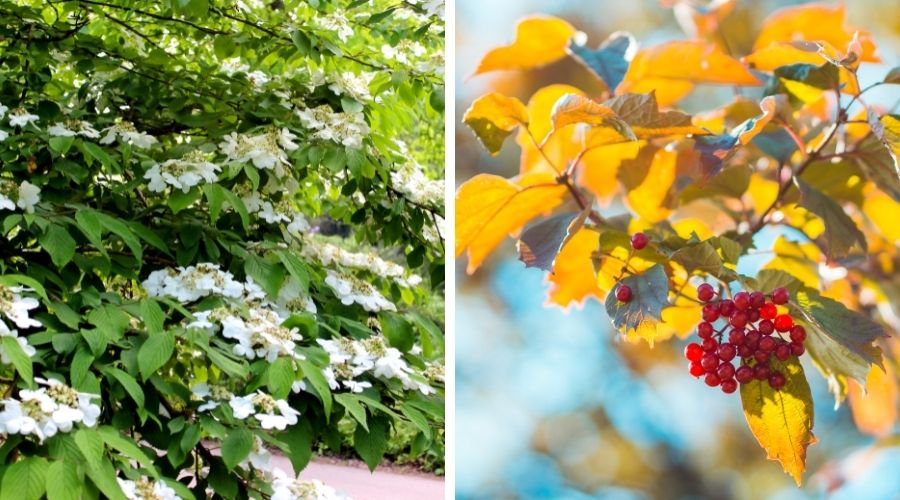
At a Glance
- Fall foliage: Red to purple
- Spring flowers: Small white clusters
- Size: Up to 25 feet, depending on the type and whether pruned into a tree
- Planting requirements: Moist well-drained soil, partial shade
- Issues: Can develop mildew if planted in a location with too much shade.
Popular Varieties
- Arrowwood – purplish-red fall leaves
- Mariesii – great structure and habit
- Blue Muffin
- Cayuga
- Mohican – pinkish flowers
- Korean Spice
About Viburnum
Viburnums, sometimes called cranberry bushes, are large flowering shrubs or small trees – some are deciduous and some are evergreen. The flowers are usually white or pink. The fruit, a type of berry, can be red, purple, blue, or black. While some kinds are edible, others are poisonous to humans.
Blackhaw viburnum (Viburnum prunifolium) is one of the viburnums native to Michigan and has white spring flowers and purplish-red fall leaves.
Another native variety, Viburnum lentago, is commonly known as nannyberry. It can be grown as a tree (up to 20-25 feet tall) or as a shrub. It also has white flowers and dark red fall leaves. The berries are bluish-black and stay on the tree throughout winter, providing food for birds and other animals.
Viburnum shrubs can work well as privacy barriers – one website suggests planting viburnums with ninebarks, which is a great way to combine two of the shrubs that we’ve mentioned in this article.
Ready to Plant Some Shrubs?
These colorful flowering shrubs all do well when planted in the fall, but they can be planted in the spring as well.
We hope you found this article interesting and educational as you decide which plants or trees to add to your own property. If you still have questions about what plant might work best for your yard, contact the experts at Bay Landscaping.






